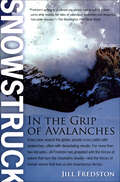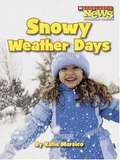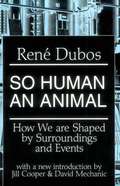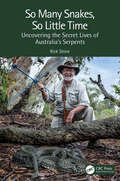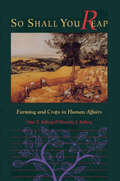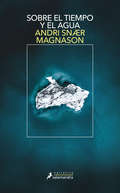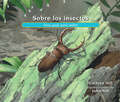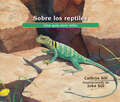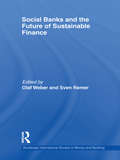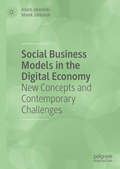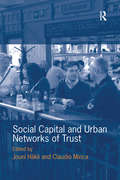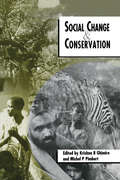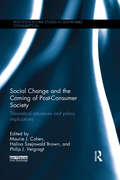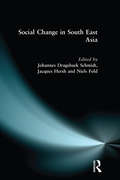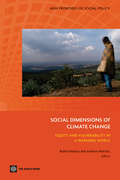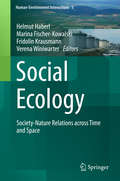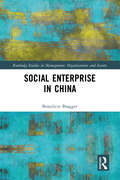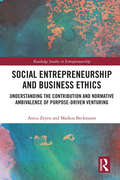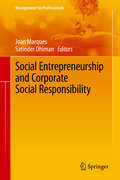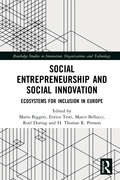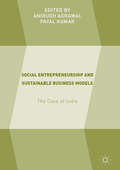- Table View
- List View
Snowstruck: In the Grip of Avalanches
by Jill FredstonEvery year around the globe, people cross paths with avalanches-some massive, some no deeper than a pizza box-often with deadly results. Avalanche expert Jill Fredston stalks these so-called freaks of nature, forecasting where and when they will strike, deliberately triggering them with explosives, teaching potential victims how to stay alive, and leading rescue efforts when tragedy strikes. Having spent decades trying to keep avalanches and people apart, Fredston brings them together unforgettably in Snowstruck. From a rare store of personal experience, she conveys a panorama of perspectives: a skier making what may prove his final decision, a victim buried so tightly that he can't move a finger, rescuers racing both time and weather, forecasters treading the line between reasonable risk and danger. Seamlessly interweaving these accounts, Fredston brings to life the awesome forces of nature that can turn the mountains deadly-and the equally inexorable forces of human nature that lure us time and again into treacherous terrain.
Snowy Owl Scientist (Scientists in the Field)
by Mark WilsonAre the snowy owls in trouble? Venture into the Alaskan arctic and the summer realm of these predator birds to find out. Discover the diverse species necessary to owl survival, how climate change is affecting the landscape of their nesting site of past millennia, and what it takes to do field research in this action-packed addition to the award-winning Scientists in the Field series.It's July on Alaska's North Slope, and scientist Denver Holt is in Utqiagvik surveying nests. Denver has been coming here since 1992, and the snowy owls he studies have been coming here much longer: thousands of years.With its mix of coastal, low-elevation tundra and a rich presence of lemmings, the North Slope is the only area in Alaska where snowy owls regularly nest. How do snowy owls decide where they will nest? How do they manage to arrive at locations where food will be abundant? What drives the success of these delicate tundra ecosystems? These are the mysteries Denver is trying to solve to help ensure a bright future for these elegant hunters.
Snowy Weather Days (Scholastic News Nonfiction Readers)
by Katie MarsicoExplains what snow is and describes what is done with it when it falls on the ground.
So Human an Animal: How We Are Shaped by Surroundings and Events
by René DubosIn this collection of stories, the bizarre is rendered normal, the absurd hilarious and the incredible comprehensible. The re-imaginations of reality feature evocations of historical figures, over-televised game show hosts and late-night comedians.<P><P> Pulitzer Prize Winner
So Many Snakes, So Little Time: Uncovering the Secret Lives of Australia’s Serpents
by Rick ShineSnakes are creatures of mystery, arousing fear in many people but fascination in a few. Recent research has transformed our understanding of the behaviour and ecology of these animals, revealed their important roles in diverse ecosystems, and discovered new and effective ways to conserve their populations and to promote coexistence between snakes and people. One of the leading contributors to that scientific revolution has been Prof Rick Shine. Based in Australia, whose snake fauna is diverse and often dangerous, his experiences and anecdotes will inspire a new generation of serpent scientists. Spellbinding stories highlight the challenges, frustrations, and joys of discovery, and give the reader a greater appreciation of these often-slandered slithering reptiles.Key Features Documents the important role played by a preeminent herpetologist. Focuses on research conducted in Australia, especially on snakes. Summarizes highly influential conservation studies. Explores the ways in which research has deepened our understanding of snakes.
So Shall You Reap: Farming And Crops In Human Affairs
by Otto Solbrig Dorothy J. SolbrigSo Shall You Reap is a broad-gauged exploration of the intersections of farming and history. Beginning with the prehistorical era, Otto and Dorothy Solbrig describe the evolution of farming. When and how did people learn to irrigate, to fertilize, to rotate their crops -- and why? Along with its fundamental importance to history, farming has radically altered the physical world. Natural landscapes have been completely transformed to provide room for growth on a large scale of a few species of plants and even fewer species of domesticated animals. Agriculture has altered the earth's biosphere and changed its geosphere: The soil has been modified, forests have been felled, swamps have been drained, rivers have been dammed and diverted. So Shall You Reap presents a fresh and informed perspective on how farming and the crops we grow have changed us and our environment. By understanding the nature of the origins and evolution of agriculture, we will be better prepared to anticipate what the future may hold in store, and what must be done to increase food production while minimizing environmental problems.
Sobre el tiempo y el agua
by Andri Snaer MagnasonUn libro para comprender el futuro del planeta si no actuamos de inmediato. Sobre el tiempo y el agua es un ensayo narrativo profundo y convincente sobre la crisis medioambiental global y, a la vez, una íntima y desesperada súplica al mundo. Nació de una conversación con un científico puntero convencido de que son los escritores, y no los científicos, los más capacitados para hablar de uno de los asuntos más apremiantes para la humanidad. Los argumentos que esgrime son, pues, indistintamente mitológicos o científicos, anecdóticos o estrictamente morales y filosóficos. El resultado es un rico entramado de relatos de viaje, historias familiares, momentos poéticos: un libro bellísimo, a la vez que urgente.
Sobre los insectos: Una guía para niños (About. . .)
by Cathryn SillThis beginner's guide to insects is a must-have for bug-obsessed young learners as well as for those who are simply curious about these creatures. In this Spanish-language addition to the acclaimed About... series, author and educator Cathryn Sill uses simple, easy-to-understand language to teach children what insects are, how they look, how they move, what they eat, and where they live. With beautifully detailed, realistic paintings, noted wildlife illustrator John Sill introduces readers to a wide variety of insects, from ants and beetles to grasshoppers and the monarch butterfly. An afterword provides further details, inspiring young readers to learn more.
Sobre los mamíferos: Una guía para niños (About. . .)
by Cathryn SillAn award-winning first glimpse into the diverse natural world of mammals--now in Spanish.This addition to the acclaimed About... series explains to children in simple, easy-to-understand language what mammals are, what they eat, and where they live. Beautifully detailed, realistic paintings by wildlife illustrator John Sill introduce readers to the huge variety of mammals, from the tiny white-footed deermouse to the large American bison. An afterword provides more details about the animals featured in the book. Parents and pre-school and primary-grade teachers will find this an attractive choice for introducing kids to mammals.
Sobre los pájaros: Una guía para niños (About. . .)
by Cathryn SillAn award-winning, educator-approved first book on birds--now in Spanish.In this simple volume, educator and author Cathryn Sill uses clear, easy-to-understand language to teach children what birds are, what they do, and how they live. Noted wildlife illustrator John Sill provides beautifully detailed, realistic paintings to showcase the birds' diverse and natural worlds, and an afterword provides more details about each bird and inspires further learning.
Sobre los reptiles: Una guía para niños (About. . .)
by Cathryn SillGot a fan of snakes, lizards, and turtles? Dig into this beginner's guide to reptiles from Cathryn and John Sill, creators of the award-winning About... series.Author and educator Cathryn Sill explains in simple language the basic characteristics that all reptiles share, while offering a look at many of the animals that fall into this diverse category, including ever-popular lizards, snakes, and turtles. The beautifully detailed paintings of noted wildlife illustrator John Sill depict reptiles in their habitats and highlight their unique aspects. An afterword provides more detail on each reptile, inspiring further learning.
Social Banks and the Future of Sustainable Finance (Routledge International Studies In Money And Banking Ser. #64)
by Olaf Weber Sven RemerSocial Banking describes a way of value-driven banking that has a positive social and ecological impact at its heart, as well as its own economic sustainability. Although it has a long and successful history, it has arguably never been more topical than it is now in the aftermath of the latest financial crisis. Most Social Banks came out of this crisis not only unscathed but much stronger and bigger than they were before. And contrary to their conventional peers, none of the Social Banks had to be bailed out with public funds. This increasingly attracts the interest not only of clients searching for safe and sensible ways to deposit their funds but also of conventional banks that begin to understand the potential of a more socially oriented approach towards banking. Social Banks and the Future of Sustainable Finance is the first book to deliver a comprehensive and detailed overview about the past, present and possible future of Social and Sustainable Banking for researchers, students and a professional audience. The authors are experts from research and practice and have bee involved in Social Banking for many years. Thus they combine state-of-the-art expertise with valuable insider knowledge. The book covers the following topics: the history of Social Banking, the need for Social Banking in the current economy, the particular issues of managing a Social Bank as business enterprise, Social Banking products and services, the special role of donations and foundations for financing change, the opportunities and challenges for Social Banks lying ahead, and concrete directions for the future of Social Banking. In addition to these respective analyses are many real-world examples and interviews with representatives of Social Banks. As such, this comprehensive collection delivers valuable insights for academics, students and professionals who are interested in the growing field of Social Banking.
Social Business Models in the Digital Economy: New Concepts and Contemporary Challenges
by Adam Jabłoński Marek JabłońskiFilling a gap in the current literature, this book addresses the social approach to the design and use of innovative business models in the digital economy. It focuses on three areas that are of increasing importance to businesses and industry today: social issues and sustainability; digitization; and new economic business models, specifically the sharing and circular economies. The authors aim to solve current scientific concerns around the conceptualization and operationalization of social business models, addressing management intentions and the impact of these models on society. Based on observation of social phenomena and the authors' research and practical experience, the book highlights best practices for designing and assessing social business models.
Social Capital and Urban Networks of Trust
by Jouni HäkliThis is the first book on social capital and trust informed by a critical geographical perspective. The authors examine the role of social capital in the constitution and reproduction of urban networks of trust in different places and contexts. They explore how social capital and trust are reflected in the capacity of these networks to achieve their goals and to deliver specific forms of urban development in a number of Finnish and Italian cities. Finland and Italy present, in many ways, two almost paradigmatic cases of how social capital and trust can work in extremely different and yet very effective ways in the production of the urban. They are two almost ideal laboratories for experimenting new definitions and new understandings of the concepts in question.
Social Change and Conservation (Earthscan Library Collection: Sustainable Development Set Ser.)
by Krishna B. Ghimire Michel P. PimbertProtected areas and conservation policies ore usually established with only local nature and wildlife in mind. Yet they con have far reaching consequences for local populations, often undermining their access to resources and their livelihoods. This book is the first comprehensive discussion of the social consequences of protected area schemes and conservation policies. Drawing on case studies from North America, Europe, Asia, Central America and Africa, it critically reviews current trends in protected area management, and shows how local people have been affected in terms of their customary rights, livelihoods, wellbeing and social cohesion. The loss of secure livelihoods ultimately threatens conservation, as poverty and environmental degradation intensify in and around protected areas. The leading authorities who have contributed to this ground breaking volume argue for a thorough overhaul of conservation thinking and practice.
Social Change and the Coming of Post-consumer Society: Theoretical Advances and Policy Implications (Routledge-SCORAI Studies in Sustainable Consumption)
by Maurie J Cohen Halina Szejnwald Brown Philip J VergragtConsumer society is an unquestionably complex social construct. However, after decades of unremitting dominance there are signs emerging that it is starting to falter, both as a coherent and durable system of social organization and as a strategy for societal advancement. Debates concerning how we can transition beyond present energy- and materials-intensive consumer society are beginning to gain greater salience. Social Change and the Coming of Post-Consumer Society aims to develop more complete appreciation of the relevant processes of social change and to identify effective interventions that could enable a transition to supersede consumer society. Bringing together leading interdisciplinary experts on social change, the book identifies and analyzes several ongoing small- and modest-scale social experiments. Possibilities for macro-scale change from the interlinked perspectives of culture, economics, finance, and governance are then explored. These contributions expose the systemic problems that are emblematic of the current condition of consumer society, specifically the unsustainability of prevailing consumption practices and lifestyles and the persistence of inequalities. These observations are summarized and extended in the final chapter of the book. This volume will be of great interest to students and scholars of sustainable consumption, sustainability transitions, environmental sociology, and sustainable development.
Social Change in South East Asia: New Perspectives
by Niels Fold Jacques Hersh Johannes Dragsbaek SchmidtProvides a comprehensive and in-depth examination of the ongoing process of development and societal transformation in a dynamic region of the Third World. Written by a team of specialists from the fields of development studies, sociology and political economy, the book looks at some of the fundamental problems facing South East Asia by addressing the following issues: the social constellations; class, culture and political legitimation; and industrialisation and labour regulation.
Social Dimensions of Climate Change: Equity and Vulnerability in a Warming World
by Andrew Norton Robin MearnsClimate change is arguably the most profound challenge facing the international community in the 21st century. It is as much a challenge for poverty reduction, growth and development as it is a global environmental issue. It could undermine or reverse progress in reducing poverty and attaining the Millennium Development Goals, thereby unraveling many of the development gains of recent decades. It already threatens the livelihoods, health and well-being of millions of people worldwide, and of the poorest and most vulnerable groups in particular. And it has potentially far-reaching implications for international relations and for personal, national and regional security. While significant uncertainties still remain, tremendous strides have been made over recent years in improving scientific understanding of the human processes driving global climate change and the likely impacts on world ecosystems. What is much less well understood is how these dynamics in the physical environment will interact with those of socio-economic systems, what the consequences will be for society, and how best to address them. In order to focus attention on these previously neglected and poorly understood social dimensions of climate change, the World Bank convened an international workshop in March, 2008, with the participation of community activists, former heads of state, leaders of Indigenous Peoples, representatives of non-governmental organizations, international researchers, and staff of the World Bank and other international development agencies. This edited volume brings together revised versions of many of the papers presented during that workshop, as an initial step in taking stock of existing knowledge on the social dimensions of climate change. Several new papers were also commissioned for this volume.
Social Dimensions of the IMF's Policy Dialogue
by International Monetary FundA report from the International Monetary Fund.
Social Ecology
by Marina Fischer-Kowalski Helmut Haberl Fridolin Krausmann Verena WiniwarterThis book presents the current state of the art in Social Ecology as practiced by the Vienna School of Social Ecology, globally one of the main research groups in this field. As a significant contribution to the growing literature on interdisciplinary sustainability studies, the book introduces the purpose and nature of Social Ecology and then places the "Vienna School" within the broader context of socio-ecological and other interdisciplinary environmental approaches. The conceptual and methodological foundations of Social Ecology are discussed in detail, allowing the reader to obtain a broad overview of current socio-ecological thinking. Issues covered include socio-metabolic transitions, socio-ecological approaches to land use, the relation between actor-centered and system approaches, a socio-ecological theory of labor and the importance of legacies, as conceived in Environmental History and in Long-Term Socio-Ecological Research. To underpin this overview empirically, the strengths of socio-ecological research are elucidated in cases of cutting-edge research, introducing a variety of themes the Vienna School has been tackling empirically over the past years. Given how the field is presented - reflecting research carried out on different scales, reaching from local to global as well as from past to present and future - and due to the way the book is structured, it is suitable for classroom use, as a primer, and also as an overview of how Social Ecology evolved, right up to its current research frontiers.
Social Enterprise in China (Routledge Studies in Management, Organizations and Society)
by Benedicte BrøggerThis book explores social innovation and entrepreneurship in China. Focusing on selected social enterprises and processes, it addresses the question of "why China?", not in terms of military, economic or political ambitions, but in the terms of social innovation and welfare policies. The analyses range from detailed ethnography to discussions of broad global trends. Despite vastly improved social conditions in the country, there are still unresolved issues that social enterprises address. The study elaborates on the complexities involved in their positioning between the state and their beneficiaries. Adding to the complexity is China’s dual system of circulation and the moral economy of ethnic minorities. The theoretical foundation of the study is the Durkheimian concept of the social contract. Its content is viewed as comprised of Maussian total social facts or guanxi, a similar Chinese framing, operationalised to particular socio-cultural configurations. The empirical cases document how social enterprises reposition elements in the various configurations in order to mobilise resources from their stakeholders. The book concludes that the discursive topology is altered in the process and the social contract is renewed in culturally meaningful, if paradoxical, ways. This book will be of interest to researchers, students and academics in the fields of business and social entrepreneurship, especially to those with a particular interest in the Chinese case.
Social Entrepreneurship and Business Ethics: Understanding the Contribution and Normative Ambivalence of Purpose-driven Venturing (Routledge Studies in Entrepreneurship)
by Anica Zeyen Markus BeckmannSocial entrepreneurs are change makers that aim to solve society’s unsolved problems. Not surprisingly, social entrepreneurship has thus created high expectations. To better understand the potential as well as the limitations of social entrepreneurship, however, a more nuanced approach is needed in two ways. First, social entrepreneurship is a multi-level phenomenon. It spans macro-level questions as well as meso-level questions and, finally, micro-level questions. If we really want to understand social entrepreneurship, we need to bring together all three levels of analysis and see how they are connected. Second, while social entrepreneurship can certainly produce socially desirable outcomes, we also need a critical perspective to capture potential undesirable effects that social entrepreneurship can cause, often unintendedly, in society, in markets, in organizations, and for individuals. To this end, an ethical perspective can help complement the positive analysis of social entrepreneurship with a discussion of the normative implications of its potential "dark side". Looking at social entrepreneurship from both a multi-level analysis and an ethical perspective, Social Entrepreneurship and Business Ethics takes the reader on a journey through the "bright side" as well as the potential "dark side" of social entrepreneurship for societies, organizations, and individuals. Highlighting both, this book not only seeks to provoke researchers and students to advance their understanding of social entrepreneurship. It also hopes to help practitioners to better realize the positive contributions of social entrepreneurship for society.
Social Entrepreneurship and Corporate Social Responsibility (Management for Professionals)
by Satinder Dhiman Joan MarquesThis book provides professionals, as well as students, with the understanding that Social Entrepreneurship and Corporate Social Responsibility (CSR) are now core business principles for sustainably. It encourages social entrepreneurs in their role as forerunners, in creating new business models that develop, facilitate or implement constructive solutions to social, cultural and environmental issues. At the same time, this book views corporate social responsibility as a means of challenging existing entities to realize and modify prior unsustainable and predatory business models; and to increase social, cultural and environmental accountability. By linking these two concepts, this book prompts a paradigmatic awakening, whereby the foundational driver of business creation and management no longer rests on profit maximization, but on improvement of the quality of life for society.
Social Entrepreneurship and Social Innovation: Ecosystems for Inclusion in Europe (Routledge Studies in Innovation, Organizations and Technology)
by Mario Biggeri Enrico Testi Roel During Marco Bellucci H. Thomas PerssonThis book provides comprehensive and advanced analysis of the characteristics of social entrepreneurship in Europe. It offers innovative, up-todate research on the ecosystems of social entrepreneurship, the behavior of social entrepreneurs, their ability to produce social innovation, social capital and social inclusion, and the role of stakeholders in fostering socially oriented businesses. Moreover, it addresses the diversity of the European social enterprise sector from an evolutionary perspective, with particular reference to the rise of social entrepreneurship and the role of new-generation social entrepreneurs throughout Europe. Multidisciplinary contributions authored by experts from business and accounting, economics, and sociology serve the purpose of delivering a holistic study of social entrepreneurship, also providing the necessary data for delivering policy implications on the features of the most effective enabling social and institutional ecosystems. The broad approach, based on different theoretical frameworks and methodologies across numerous disciplines, enables the authors to tackle all of the complex research issues connected to social entrepreneurship in the region. The book builds on the results of the European Union 7FP (European Union’s Research and Innovation funding program for 2007–013)-funded “EFESEIIS – Enabling the flourishing and evolution of social entrepreneurship for innovative and inclusive societies” research project. The central theme of the book is an evolutionary perspective on the dynamics and the rise of the social enterprise in Europe. This evolutionary perspective can be used in an economic as well as a social longitudinal analysis of changing contexts and entrepreneurial practices. The evolutionary perspective will be used as a tool to account for the specificity of developmental pathways in different contexts and countries.
Social Entrepreneurship and Sustainable Business Models: The Case Of India
by Payal Kumar Anirudh AgrawalAddressing the need for further theorisation and operationalisation of social entrepreneurship in India, this edited collection provides a critical and deeper understanding of the social entrepreneurial ecosystem. Covering topics such as entrepreneurial intentions, empathy, impact investment and standardised social measures, the contributors explore the potential of social entrepreneurship and sustainable business models in an Indian context. Offering empirical cases and presenting a realistic perspective of the social entrepreneurship landscape in India, this collection will undoubtedly be of value to those interested in creating a social and sustainable impact in business and society.
